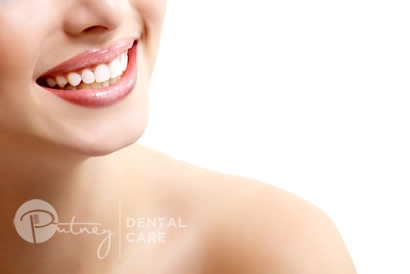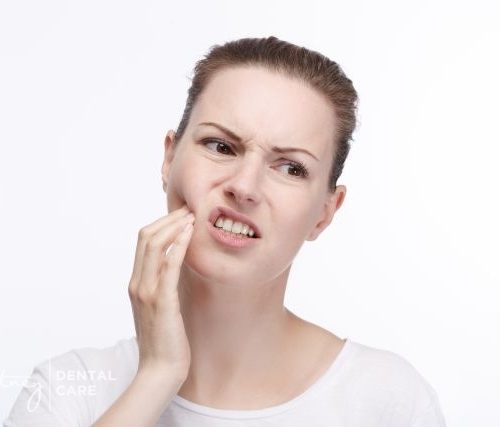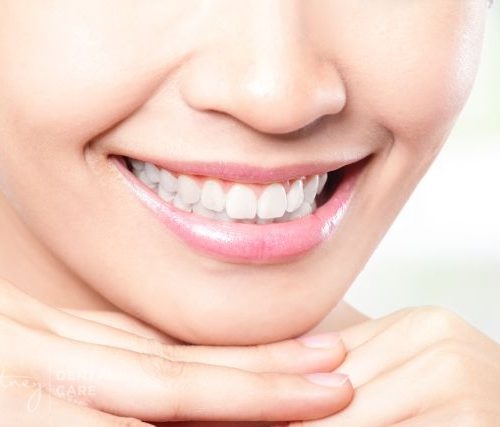Cavity vs Stain – Understanding the Differences

Wondering if you have a tooth cavity or simply a stain on your tooth? It can be tricky to tell when cavities and stains look alike, especially in the early stages.
Teeth stains are reversible, but cavities are not. Here’s a guide explaining the differences between the two and what treatments are available. Plus, how good oral hygiene and other preventative practices will reduce your risks of developing cavities and stains in the first place.
What is a Cavity?
Cavities are discoloured marks and holes that develop on or in the crevices of your teeth. They are the result of tooth decay, which is when acid-producing bacteria in the mouth erode the protective barrier of your teeth called enamel.
Tooth cavities are most likely to form on your back molar teeth where you chew food, between your teeth or near where your teeth meet your gums. Starting out as small markings, cavities will worsen when left untreated. Cavities will affect the deeper layers of your teeth and cause permanent damage.
Anyone can develop cavities, even young children. However, cavities are usually related to poor dental hygiene or consuming certain types of food and drinks that cling to your teeth or are high in sugar.
Causes of Cavities
Anything that contributes to tooth decay will create a cavity if left untreated. Cavities are quite common, especially in people with a family history of cavities. Tooth decay and cavities can be caused by:
- Poor oral hygiene
- Buildup of plaque and tartar
- Sugary or acidic drinks and foods
- Bacteria in the mouth
- Frequent snacking
- Lack of protective fluoride treatments
- Dry mouth
What is a Tooth Stain?
Tooth discolouration and stains are visual marks on the tooth surface (extrinsic) or underneath the enamel (intrinsic) or surface of teeth. They can affect one specific area or be spread across multiple teeth. Stains can be yellow, brown, black, white and even purple, the latter of which can show up for regular red wine drinkers.
Causes of Tooth Stains
While residue from certain food and drinks commonly leaves stains on your teeth, there are other causes. Poor dental hygiene, tartar buildup, age, tobacco use, excessive fluoride treatments, trauma, medical treatments and illness can also discolour your teeth.
Certain foods that cause stains to develop on your teeth include:
- Coffee
- Tea
- Red wine
- Tomato based sauces
- Dark fruit juices, sports or soft drinks
- Dark coloured fruits and vegetables like berries or beetroot
- Soy sauce and balsamic vinegar
- Chocolate and dark candies
- Curry
How to Tell the Difference Between a Tooth Stain and a Cavity
Often cavities and stains on your teeth look similar as they develop. Cavities tend to grow larger and deeper steadily over time. Whereas, stains vary in size and shape, often shrinking and growing depending on other circumstances.
The main difference between the two is that cavities are permanent damage to the teeth, while stains are usually temporary and only affect the appearance of your teeth. How you tell the difference between cavities and stains comes down to examining the symptoms and appearance of your teeth.
Symptoms
Stains on your teeth are only visibly noticeable. They don’t come with any additional symptoms, discomfort or affect the health or use of your teeth. Tooth cavities on the other hand, usually come with symptoms.
Confusingly, some people who get cavities don’t always experience symptoms and this is why they may mistake their cavity for a stain. It can be hard to notice or feel cavities in between teeth or in the crevices of your teeth. As opposed to a cavity that’s developed in a molar tooth that is regularly used to chew food.
Visit your dentist for a full check up if you have any of the below symptoms of a cavity:
- Sensitivity, tooth pain or nerve pain
- Discomfort when biting
- Sudden toothache or pain
- Pain when consuming sweet, hot or cold foods and drinks
- Consistent pain (can move upwards to the jaw and ears)
- Bad breath or taste in your mouth
- Bleeding or swollen gums
Appearance
Tooth cavities are targeted discoloured marks, holes, pits or dents in your teeth. While stains tend to be more evenly spread across your teeth and can affect an entire tooth or group of teeth.
Both stains and cavities share similarities in colour and can be white, brown and black. White marks tend to signal a cavity is beginning to form and grey marks indicate a cavity has developed. While, yellow marks are usually stains or discolouration from food residue or tobacco use.
Examinations
Unsure whether it’s a tooth stain or cavity? Between dentist appointments, examine your own teeth regularly by yourself or with the help of another to:
- Keep track of any changes in appearance on all surfaces of your teeth
- Touch darkened areas with slight pressure to see if there is pain or sensitivity
- Bite on or into something harder like an apple to test for pain
- Run your tongue over the surface of your teeth to check for holes
- Test if you feel a difference when you consume hot of cold foods and drinks
- Look in the mirror with your mouth wide open and head titled to check for any marks, especially on molar or incisor teeth surfaces that you use to bite and chew with. Use a flashlight if you need or ask someone to look inside your mouth and take a photo
- Check your breath or taste in your mouth for foul indications of tooth decay
Treatment
Treatments of teeth stains and cavities are vastly different. Stains can easily be aesthetically treated at home or by a cosmetic dentist. Cavities require the opinion and advice from a dental professional to know the right course of action for treatment personal to you.
Stains
In some early cases, tooth stains can disappear after brushing your teeth or by changing your diet. When this is not the case, treating stains on your teeth can be done at home or by a professional at your dentist’s office.
Stains on the outside of your teeth, known as extrinsic discolouration, are the easiest to remove as they haven’t penetrated inside the tooth yet. Standard at-home whitening toothpaste or strips can remove these surface stains over time. Just be careful not to overdo it as these methods can be abrasive and damage the enamel of your teeth, causing greater issues. For a safer option, get a do-it-yourself teeth whitening kit from your dentist.
For intrinsic stains that are underneath the surface of your teeth, or worn away yellowed enamel called dentin, you will need the advice of a dental professional on your treatment options. These types of teeth stains are harder to remove and require skilled cosmetic dentistry treatments. Such as professional teeth whitening that will last several years or other restorative procedures suited to your individual needs.
Cavities
Once you have noticed a cavity, you should schedule an appointment with your dentist as soon as possible. Cavities are irreversible and when left untreated, can become larger and deeper quickly. When caught early, treating cavities is simpler and less invasive.
Cavities can spread inside the layers of your teeth and damage the inner nerve. With time, cavities can cause greater tooth sensitivity, severe pain, infection, gum disease, tooth fracturing and even tooth loss.
Your dentist will recommend a restorative treatment option based on the size and extent of the cavity:
- Tooth fillings are the most common cavity procedure when the structure of the tooth is still intact. After removing the tooth decay, your dentist will fill in the remaining hole in your teeth with a specific filling like resin, porcelain or gold to restore the function and shape of the tooth.
- Crowns are used to restore the function and look of teeth severely affected by one or more cavities. Usually made from ceramic, dental crowns are created to look like your existing teeth and are caped over the treated damaged tooth.
- Root canal treatments may be required if your cavity causes injury to your tooth nerve or has become a serious infection. Depending on the extent of the damage, after a root canal treatment, you will either be fitted with a crown or given a type of tooth filling.
Prevention
Prevention is always better than the cure when it comes to your oral health. Taking care of your teeth and gums is crucial in ensuring they last you a lifetime. Alongside proper oral hygiene, ideally you should be visiting your dentist every 6 months for a clean and check-up. This is key to preventing all minor and major dental problems.
Stains
Preventing stains and tooth discolouration comes down to how you clean your teeth or what you consume. Keep your teeth looking white and stain-free by:
- Brushing and flossing your teeth twice a day for least 2-3 minutes, ideally after meals
- Remove surface stains with whitening toothpaste
- Limiting food and drinks that stain your teeth – e.g. sugary, acidic and dark in colour
- Drinking water or rinsing out your mouth after eating or drinking
- Quitting smoking and use of other tobacco
Cavities
Tooth decay is preventable and reversible if treated early, before it becomes worse and creates a permanent cavity. Protect your teeth against tooth decay and cavities by making sure to:
- Brush your teeth and floss twice a day for at least 2-3 minutes
- Use fluoride toothpaste
- Drink water or rinse your mouth after consuming food and beverages
- Limit sugary and acidic foods and drinks
- Drink 1-2L of water daily
- Try using an antimicrobial mouthwash after brushing your teeth
- Eat nutritious foods with zinc and calcium to protect your tooth enamel
- Keep up fluoride treatments
- Don’t overlook signs of a cavity or tooth decay – visit your dentist ASAP
FAQs
Is a Tooth Stain a Sign of a Cavity?
Marks on your teeth could indicate a cavity or stain, but they are not always related. Either way, it’s important to visit your dentist for their expert opinion and advice on treatments.
Can you Brush Away a Cavity?
No. A cavity causes permanent damage to the inner layers of your tooth. Brushing the area will likely feel painful. Visit your dentist for advice on how best to treat your cavity as soon as you notice it.
Is a Brown Spot Always a Cavity?
No. Both stains and cavities can appear as brown spots on your teeth. Stains aren’t painful but cavities are. Tell tale signs of a cavity are teeth sensitivity, holes or markings in white, grey or black on teeth.
Is Black Stain a Cavity?
No, but it could be. Both cavities and teeth stains can be black in colour. If you have other symptoms like pains, sensitivity or visible holes in your teeth, you most likely have a cavity.
Tartar vs Plaque: What’s the Difference? Root Canal vs Filling: What Procedure Do I Need?Latest from the Dental Blog
 11 Apr 2018
11 Apr 2018
How often should I go to the Dentist?
Nothing holds truer than the adage “Prevention is better than cure” in the dental industry. But most of the time,…
 07 Aug 2020
07 Aug 2020
Bruxism And TMJ; What Is The Difference?
From time to time it is normal to have unexplained pain in your teeth and gums, but if it is…
 06 Apr 2017
06 Apr 2017
Teaching Oral Health To Children
At Putney Dental Care, we are strong advocates for teaching children to observe oral hygiene. It is a very important…
